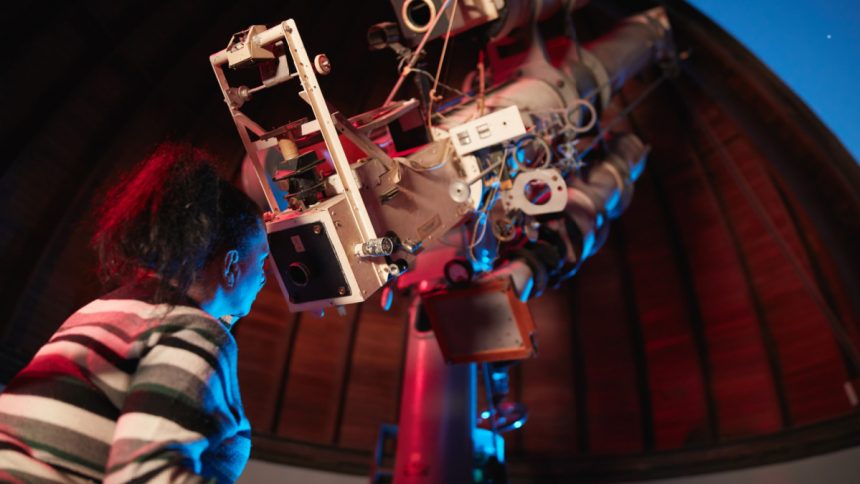The most detailed measurement of dark energy to date could reshape our understanding of how quickly the universe is expanding, with new research from an international team of scientists – including astronomers from The Australian National University (ANU), Swinburne University of Technology, and the University of Queensland – challenging previous thinking.
The Dark Energy Survey (DES) represents the work of over 400 astrophysicists, astronomers and cosmologists from more than 25 institutions.
Across a six-year period, DES scientists took data for 758 nights to understand the nature of dark energy and measure the expansion rate of the universe. They found that the density of dark energy in the universe could have varied over time, according to a new complex theory.
Revolutionary analysis is major scientific progress
Dr Anais Möller from Swinburne University of Technology’s Centre for Astrophysics and Supercomputing was part of the team working on this revolutionary analysis, alongside Swinburne’s Mitchell Dixon, Professor Karl Glazebrook and Emeritus Professor Jeremy Mould.
“These results, a collaboration between hundreds of scientists around the world, are a testament to the power of cooperation and hard work to make major scientific progress,” says Dr Möller.
“I am very proud of the work we have achieved as a team; it is an incredibly thorough analysis, which reduces our uncertainties to new levels and shows the power of the Dark Energy Survey. We not only used state-of-the-art data, but also developed pioneering methods to extract the maximum information from the Supernova Survey. I am particularly proud of this, as I developed the method to select the supernovae used for the survey with machine learning.”
Dark energy makes up large part of our universe
In 1998, astrophysicists discovered that the universe is expanding at an accelerating rate, attributed to a mysterious entity called dark energy that makes up about 70 per cent of our universe. At the time, astrophysicists agreed that the universe’s expansion should be slowing down because of gravity.
Now, 25 years after the initial discovery, the Dark Energy Survey is a culmination of a decade’s worth of research from scientists worldwide who analysed more than 1,500 supernovas using the strongest constraints on the expansion of the universe ever obtained.
The outcome results are consistent with the now-standard cosmological model of a universe with an accelerated expansion. Yet, the findings are not definitive enough to rule out a possibly more complex model.
“There is still so much to discover about dark energy, but this analysis can be considered as the gold standard in supernova cosmology for quite some time,” says Dr Moller.
“This analysis also brings innovative methods that will be used in the next generation of surveys, so we are taking a leap in the way we do science. I’m excited to uncover more about the mystery that is dark energy in the upcoming decade.”
Pioneering a new approach with collaboration
“Our findings hint that the density of dark energy may change with time, which if confirmed would be revolutionary,” PhD student Patrick Armstrong, from the ANU Research School of Astronomy and Astrophysics, says.
Dr Brad Tucker, also from ANU, says: “A dark energy that evolves with time would represent a huge change in our understanding of dark energy, and one that frankly is just weird.”
“Understanding the contents and evolution of the universe is huge focus of research. The closer we get to understanding what darkenergy is, the more we understand what the universe is as a whole,” Dr Tucker told EducationDaily. “If darkenergy is vacuum energy, the energy of empty space, or something that changes with time and is some sort to new energy, that will completely change everything and our understanding of the universe – and even how we got here.”
He describes being part of the collaborative DES project as “exciting” – “especially something that has been years in the making, the many nights observing, and all of the work to get to this point and result”.
“We sometimes see science as the long genius who comes up with the answer all by themselves,” he told EducationDaily. “Science is really about lots of hard work, with lots of great people contributing to a big answer – and this is the perfect example of this. Moreover, when you get so many people you get many viewpoints. You may think your idea is best but think someone else has a better idea that without talking to them, you would have never known about.”
Exploring the bright, explosive lives of stars
The scientists sifted through data of about two million distant galaxies to identify and classify an “unprecedented” sample of almost 1,500 supernovae – a phenomenon where stars reach the end of their life cycle and die bright, explosive deaths.
Many of these supernovae are so far away from us that the light astronomers can observe through telescopes was emitted before the Earth even formed.
“Never before have so many distant supernovae been observed and analysed – we’re at the tip of the iceberg and it’s truly an exciting time,” Mr Armstrong says.
“The nature of dark energy is still out there to be discovered – this new method will help future generations of stargazers to explore its mysteries.”
Type Ia supernovae occur when an extremely dense dead star, known as a white dwarf, reaches a critical mass and explodes. This new method uses machine learning to classify types of supernovae explosions based on their colours.
Dr Georgie Taylor from ANU, who was also involved in the research, says: “All type Ia supernovae have about the same actual brightness. So, when we measure the brightness of two of these supernovas as seen from Earth, we can then calculate their distance from us – shedding light on the mystery of how quickly our universe is expanding.”








